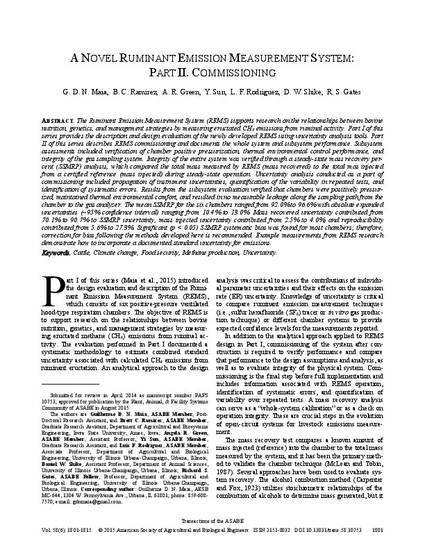
The Ruminant Emission Measurement System (REMS) supports research on the relationships between bovine nutrition, genetics, and management strategies by measuring eructated CH4 emissions from ruminal activity. Part I of this series provides the description and design evaluation of the newly developed REMS using uncertainty analysis tools. Part II of this series describes REMS commissioning and documents the whole system and subsystem performance. Subsystem assessments included verification of chamber positive pressurization, thermal environmental control performance, and integrity of the gas sampling system. Integrity of the entire system was verified through a steady-state mass recovery percent (SSMRP) analysis, which compared the total mass measured by REMS (mass recovered) to the total mas injected from a certified reference (mass injected) during steady-state operation. Uncertainty analysis conducted as a part of commissioning included propagation of instrument uncertainties, quantification of the variability in repeated tests, and identification of systematic errors. Results from the subsystem evaluation verified that chambers were positively pressurized, maintained thermal environmental comfort, and resulted in no measurable leakage along the sampling path from the chamber to the gas analyzer. The mean SSMRP for the six chambers ranged from 92.0% to 96.6% with absolute expanded uncertainties (~95% confidence interval) ranging from 10.4% to 13.0%. Mass recovered uncertainty contributed from 70.1% to 90.7% to SSMRP uncertainty, mass injected uncertainty contributed from 2.5% to 4.0%, and reproducibility contributed from 5.6% to 27.3%. Significant (p < 0.05) SSMRP systematic bias was found for most chambers; therefore, correction for bias following the methods developed here is recommended. Example measurements from REMS research demonstrate how to incorporate a documented standard uncertainty for emissions.
Available at: http://works.bepress.com/brett-ramirez/18/

This article is published as Maia, Guilherme D. N., Brett C. Ramirez, Angela R. Green, Yi Sun, Luis F. Rodriguez, Daniel W. Shike, and Richard S. Gates. "A novel ruminant emission measurement system: Part II. Commissioning." Transactions of the ASABE 58, no. 6 (2015): 1801-1815. DOI: 10.13031/trans.58.10753. Posted with permission.